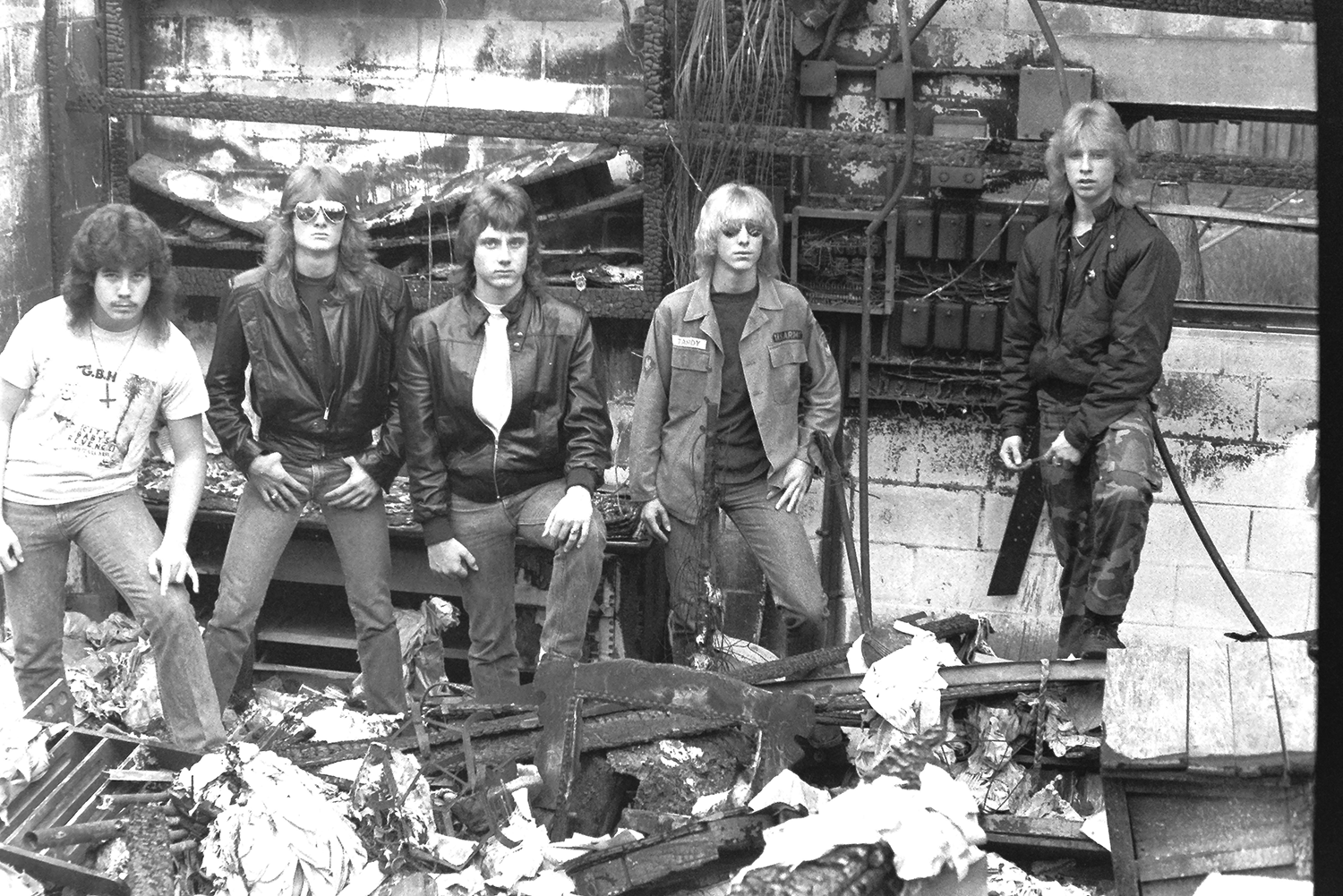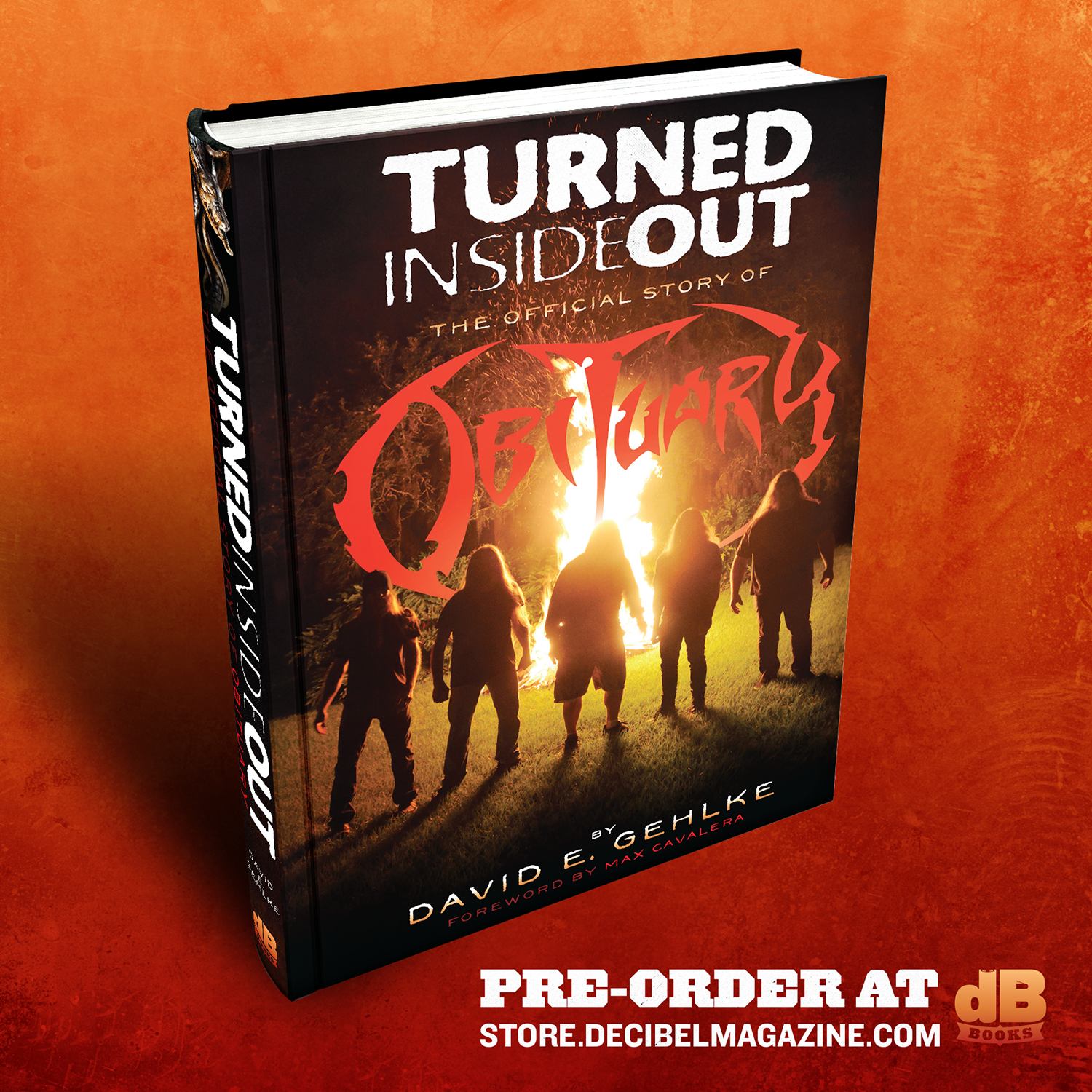
Decibel Books recently announced the pre-order for Turned Inside Out: The Official Story of Obituary, and today Decibel is proud to share the first excerpt from this 328-page hardcover book authored by David E Gehlke (No Celebration: The Official Story of Paradise Lost, Damn the Machine: The Story of Noise Records). The following passage takes readers back to the mid-’80s when Obituary’s founding core of John Tardy, Donald Tardy and Trevor Peres were about to discover a sound that would change the course of death metal history.
During a 1985 Executioner practice, John Tardy stood quietly in the corner of his parents’ garage while his bandmates bashed away on “I’m in Pain,” a new Trevor Peres composition. One of the many tracks to emerge from Peres’ Celtic Frost-inspired songwriting run, “I’m in Pain,” had a unique arrangement—its chorus was placed at the very end, eschewing the conventional song structure Peres was already doing his best to avoid. The heavier direction Peres was taking Executioner required a different approach from John, who came away from the Metal Up Your Ass demo thinking there was more he could do as a vocalist. He was confident, though, that he no longer wanted to sound like a thrash singer. John had to find a way to match Peres’ fiendishly heavy guitar tone and his brother Donald’s dynamic style of drumming.
As his bandmates continued to hammer away at “I’m in Pain,” John hovered around the microphone. He had a basic grasp of what to do during the song’s verses (parts that would eventually be rewritten), but something about the chorus stood out. He strode back and forth as the song’s riffs and rhythms emanated from Donald, Peres, bassist Jerome Grable and freshly inserted new lead guitarist Mark Vittoe. When the chorus came around, he suddenly grabbed the microphone stand, reared back and, with every ounce of froth, aggression and fury in his not-even-18-year-old body, unleashed the line of “Help me, I’m in pain!”
Peres, Donald, Grable and Vittoe each looked at each other, astonished.
“What the hell was that?” asked Peres. “That was badass!”
“We have to do that again!” yelled Donald from behind his kit. “Let’s go!”
Executioner then launched back into the song, each member almost hurrying their pace so they could get to the chorus, anticipating what John would do next:
“HELP ME, I’M IN PAIN!”
The song ended, and a satisfied John Tardy had now stumbled upon a vocal style that altered the course of both Executioner and death metal history.
“It was surprising that I was able to sing like that, but also scary,” he admits. “When I started doing vocals like that, I got tired really fast. I would also get hoarse very quickly in those early days. We weren’t touring or anything, so I hadn’t fully developed the style or the stamina. I remember some of the early shows that we did, and I felt exhausted after a few of them. It took me several years to get to the point where I am today. I just worked on things. It’s a weird style; it’s a weird concept. So many people hate death metal, and I completely understand why—it’s because of the vocals. Yet, most Obituary fans like Obituary because of the vocals. It’s a really strange thing that most of the world hates us because of me, but our fans like us because of me.”
“This was when John started to find his voice,” says Donald. “Compared to everything before that, he was horrible, and he didn’t know what he was doing, and he was trying to find his way. Then it felt like overnight, all of a sudden, he started turning into something cooler. It still wasn’t quite the ‘John Tardy’ voice yet, but he was on his way.”
“I was happy as hell when I heard them,” says Peres of John’s vocals. “I was so deep into Venom, Possessed and, of course, Celtic Frost and Hellhammer. We were always listening to that shit. It was like, ‘Yes, that’s what we want!’ That was our direction. When he did it, I said, ‘There you go, dude.’ It just got better from there. John’s vocals were so heavy to the point where they were like an extra instrument. At the end of the day, our music was about the feeling, the vibe, especially with the heavy guitar tones and brutal drumming we were doing. Put John’s new vocals into that mix, and it made my hair stand up on end.”
John had actually wanted to be a traditional metal singer like his hero, Savatage’s Jon Oliva. But aware that achieving a multi-octave range like the Savatage frontman would be out of reach, he turned his attention to Venom, whose vocalist, Conrad “Cronos” Lant, was one of the first to employ a “gruff” style of vocals. Executioner toyed with the occasional Venom cover during practice, giving John insight into formulating more aggressive vocals. With Peres’ domineering guitar tone creating maximum heaviness, John felt compelled to try a style that was unhinged, relying on a series of sounds rather than lyrics. Without realizing it, he created a vocal style unlike anything in extreme metal.

“I tried to blend in with Trevor’s tone as much as I could,” he says. “Some of those early songs that happened when we started getting heavier, like ‘’Til Death,’ what I was doing vocally was just noises. It didn’t mean anything to me. I never found it necessary to sit down and write lyrics to our songs. I don’t know why; I just never did. As we advanced in our career, I wrote things down, but the pronunciation of things… my approach was totally caveman back then. We didn’t even know what we were doing. I just started going for it and came up with sounds off the top of my head.”
John’s transition to death metal vocals came at a pivotal time. In 1985, a small but hungry death metal scene started to brew in Florida. The undisputed first band and subsequent leaders of the scene, Death, were beginning to become more than just an idea in Chuck Schuldiner’s head. The band’s Infernal Death demo was making its way across the United States and beyond via a group of tape-traders dedicated to the cause of spreading the word of underground metal. Another contemporary was Morbid Angel, who had recently changed their name twice—first from Ice, then Heretic, and had the unique setup of their drummer, Mike Browning, also handling lead vocals.
“We were just concentrating on what we were doing,” Browning says. “It was a weird but exciting time. Heretic used to do a lot of parties. We threw our own parties where we’d go to the beach, run a generator and start playing. There was also a park in Tampa with a little-sized hill that had steps to a pavilion at the top with electrical outlets. We used to go up there and just jam. We didn’t have a PA system or anything back then. Dallas [Ward, bass], Trey [Azagthoth, guitar] and I used to get up there and start playing Jimi Hendrix rhythms and going crazy for 20 minutes.”
Also emerging on the scene was Massacre, which included the talents of a diminutive lead guitarist by the name of Allen West. Massacre played many of the same venues as Executioner—including the Mango Rec Center, which was located near Armwood Senior High School. Grable got to know Massacre bassist Mike Borders from working at the often customer-less Fotomat booth, where they would talk well into the night about their bands and the Florida scene. The two arranged a show for Executioner and Massacre in the fall of 1985 that would serve as the first time the Tardy brothers and Peres saw West play live. They recognized that night that the smallest member onstage had the most talent.
Something was starting to brew in Florida. Although many of thrash’s early top bands wouldn’t make it to the Sunshine State until several years later, local record stores like Asylum Records and Melody Music carried more than enough metallic options to quench the thirst of would-be ravenous ’bangers. Whether they knew it at the time or not, Executioner were now firmly embedded in the Tampa scene. Heading into 1986, the band now had an even clearer direction. With Peres now supplying the riffs, Grable and Donald the rhythmic backbone, Vittoe the flashy solos and John the ungodly vocals, the next 12 months were poised to be critical.
—-
Pre-order a copy of the hardcover of Turned Inside Out: The Official Story of Obituary right here.






